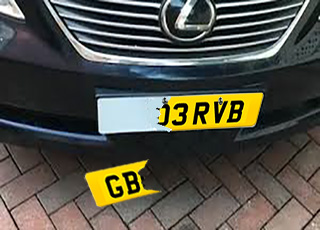Clear and easily readable number plates aren’t just a formality—they are the unsung heroes of road safety. They serve as the main identifier for vehicles, aiding not only in routine vehicle identification but also during crucial moments like accidents or law enforcement activities. In the UK, it’s not just a suggestion but a legal requirement for all vehicle owners to ensure their number plates are in top-notch condition.
Since number plates were introduced, they have been used to ensure that drivers on the road can be identified, or more specifically, their vehicle can be identified. This means that the police and the DVLA have the ability to identify vehicles from a safety perspective, insurance perspective and a crime perspective. As an example, if a hit and run takes place, then given the technology and cameras on the road, there is a high chance that the driver would be identified.
The core focus here is to stress the urgency of replacing worn-out number plates promptly. Often overlooked as mere vehicle adornments, these plates carry a weighty responsibility. Neglecting this responsibility can have substantial legal implications that drivers might not fully comprehend.
This article aims to bridge that understanding gap and illuminate the potential consequences of failing to maintain clear and legible number plates. It’s about more than just compliance; it’s about ensuring road safety, aiding law enforcement, and abiding by legal requirements. Let’s explore why this seemingly small detail is a significant factor in the larger picture of responsible vehicle ownership in the UK.
Significance of Clear and Legible Number Plates
Clear number plates aren’t just about following the law; they’re essential for effective law enforcement. They enable authorities to swiftly identify vehicles involved in traffic violations, accidents, or even more severe criminal activities. These plates also contribute to the smooth flow of traffic, especially in emergencies or congested situations, allowing for efficient vehicle tracking.
Factors Causing Number Plate Damage and Fading
Number plates, though seemingly sturdy, bear the brunt of Mother Nature’s elements and human intervention. Sunlight, the ever-present force, becomes a silent adversary over time. Its prolonged exposure can be a culprit behind the gradual fading and weathering of these plates, slowly eroding their once-bold visibility.
But it’s not just the sun—harsh weather conditions play their part in this wear and tear too. Rain, snow, and extreme temperatures become villains, gradually chipping away at the plate’s resilience. They test the limits of endurance, often resulting in cracks, fading, or the lamentable loss of characters.
Then there’s the not-so-subtle impact of road debris. Imagine a pebble kicked up by a passing vehicle, innocuous in its size, yet powerful enough to create a dent or a ding. These small impacts accumulate over time, contributing to the overall deterioration of the plate’s integrity.
And as if nature’s challenges weren’t enough, there’s the unfortunate human touch—vandalism. Whether a deliberate act of mischief or an accidental scrape, vandalism adds to the plate’s woes. It can leave behind visible scars, scratches, or damages, further compromising its readability and overall appearance.
The culmination of these factors manifests in a variety of telltale signs on number plates. Cracks, dents, fading reflective surfaces, and often, the loss or damage of characters—these are the markers of a plate that’s weathered more than its fair share. Regularly inspecting these plates becomes essential to catch these signs early and address them before they escalate, safeguarding their functionality and ensuring compliance with legal standards.
Signs Your Number Plate Needs Replacement
Recognising the indicators that signal a necessary replacement for your number plate is vital. These signs serve as clear alerts for a timely switch because taking no action simply is not an option! When cracks start appearing, even as small fissures, or dents mar the plate’s surface, it’s a visible cue for a replacement. These physical damages, alongside the fading of the plate’s characters, mean that your plates probably need changing to avoid further damage.
The characters on the plate need to be clearly displayed, so when they’re damaged, missing, or fading away, it means that your plate could be illegal. Regular checks will allow you to carry out a thorough assessment of the condition of your plate but also help you determine when to replace them.
Engaging in routine inspections serves as an effective preemptive measure. By actively seeking out these telltale signs—cracks, dents, fading, character damage—vehicle owners are taking responsibility for their own vehicle, something that is very important when you consider the legal implications and a need to be compliant.
Number plates are not just about aesthetics because they are about safety and meeting legal standards. Therefore, you should remember that the responsibility for replacing your plates falls on you. Regular checks and a prompt response to these signs are integral in ensuring that the number plates stay clear, legible, and compliant with regulations.
Legal Implications of Driving with Worn-Out Number Plates
Driving with damaged or faded number plates goes beyond appearances—it’s against the law in the UK. The Road Traffic Act 1988 sets clear rules: number plates must be easily readable. Breaking this rule can land drivers in hot water. Those caught with illegible plates may face fines that could go up to £1,000 in fixed penalty notices.
The implications don’t stop there. Non-compliant plates might create hurdles when it comes to insurance coverage in case of an accident. It could complicate the claims process, leading to potential delays or issues with insurance settlements. These plates are more than just a cosmetic concern; they’re a legal obligation that drivers must adhere to.
The act’s mandate for clear and readable number plates isn’t just a guideline—it’s a legal requirement that drivers must meet. Failing to comply can result in not just fines but also practical complications in the aftermath of accidents. It’s essential for drivers to ensure their plates meet the set standards, not just for avoiding penalties but also for smooth and hassle-free procedures in case of unforeseen incidents on the road. Being compliant isn’t just about following the law; it’s about ensuring safety, facilitating effective identification, and abiding by the regulations that contribute to a well-functioning traffic system.
Recommendations for Number Plate Maintenance and Replacement
Keeping number plates in top shape isn’t rocket science—it’s all about regular maintenance. A simple routine check for any signs of damage or fading is crucial. Once those signs show up, quick replacement is the smart move to steer clear of legal issues.
One effective way to keep plates looking sharp is professional cleaning services. These services not only ensure the plates remain visible but also enhance their durability. They’re like a rejuvenating spa day for your plates, refreshing their appearance and ensuring they stay compliant with regulations.
Investing in protective covers or coatings is another savvy strategy. It’s like giving your plates an extra layer of protection against the elements. These safeguard plates from the sun’s relentless rays, harsh weather, or even potential vandalism. This proactive measure extends the plates’ lifespan, reducing the need for frequent replacements and ensuring they stay clear and legible.
In essence, it’s about being proactive. Regular checks, swift replacements, professional cleaning, and protective coatings—they all contribute to maintaining number plates in pristine condition. These simple steps not only keep the plates compliant with regulations but also ensure their longevity. It’s a small investment that goes a long way in avoiding legal entanglements and contributing to safer roads for all.
Impact of Number Plate Condition on Vehicle Value
The impact of a vehicle’s number plate condition on its resale value should not be underestimated. While it may appear insignificant, the state of these plates holds weight in the eyes of potential buyers. Worn-out, damaged, or illegible plates can inadvertently send negative signals about the vehicle’s upkeep and care.
Clear, well-maintained plates contribute significantly to the vehicle’s overall presentation. They reflect diligence and attention to detail, signalling that the owner has taken care of the vehicle. Such plates add to the vehicle’s curb appeal, enhancing its appearance and leaving a positive impression on prospective buyers.
In contrast, worn-out or damaged plates can diminish the vehicle’s aesthetic appeal. They might hint at neglect or lack of maintenance, causing potential buyers to question the overall condition of the vehicle. It could raise concerns about whether other parts of the vehicle have also been overlooked or poorly maintained.
Potential buyers often evaluate every aspect of a vehicle when considering a purchase. Clear and legible plates suggest a well-maintained vehicle, potentially bolstering its perceived value. On the contrary, worn-out plates may inadvertently devalue the vehicle in the eyes of prospective buyers, impacting their willingness to pay a premium price.
In the competitive market of used vehicles, where every detail matters, the condition of number plates can influence the overall perception of the vehicle’s quality and care. Therefore, ensuring that the plates remain clear, legible, and well-maintained can positively contribute to a vehicle’s perceived value during resale transactions.
Technological Advancements in Number Plate Manufacturing
In recent years, technological advancements have significantly transformed the landscape of number plate manufacturing, introducing cutting-edge innovations that go beyond mere identification. Reflective materials have undergone a remarkable evolution, enhancing visibility and readability, especially in low-light conditions. These modern reflective coatings not only ensure clear identification but also contribute to improved safety on the road.
Moreover, the integration of advanced security features has revolutionised number plate manufacturing. These features, ranging from intricate patterns to embedded holograms or watermarks, serve as robust deterrents against counterfeiting or tampering. They not only add a layer of authenticity but also safeguard against fraudulent activities, ensuring the plates’ credibility and reliability.
Another notable innovation lies in integrated lighting systems. These systems, often seen in high-end or specialised vehicles, add an element of sophistication and functionality to number plates. LED lighting, for instance, can illuminate the plate, enhancing its visibility in various lighting conditions and adding an aesthetic appeal to the vehicle’s rear end.
Furthermore, advancements in manufacturing techniques and materials have allowed for the creation of durable, weather-resistant plates. These plates withstand harsh environmental conditions, maintaining their integrity and readability over prolonged periods.
Overall, these technological advancements have not only elevated the functionality of number plates but also expanded their role in vehicle safety, security, and aesthetics. As manufacturers continue to innovate, these plates cease to be just identification markers; they become integrated components equipped with features that enhance visibility, deter fraud, and contribute to the overall modernisation of vehicle identification systems.
The Digital Age and Number Plates
We have seen technology have an impact on many different parts of our lives. In the world of cars, technology is growing year on year and number plates are no different. It is fair to say that there is a possibility of seeing digital number plates on vehicles, removing the need for printed number plates. While this is a long shot, we all know that anything is possible when it comes to innovation.
Integrated vehicle communication systems represent another exciting frontier. These systems could establish a seamless network, facilitating communication between vehicles, infrastructure, and authorities. Imagine number plates that not only identify vehicles but also relay critical information, such as traffic updates, emergency alerts, or vehicle-to-vehicle communications, fostering a safer and more interconnected transportation ecosystem.
Additionally, personalised identification solutions might become more prevalent. From customisable designs to plates linked to driver preferences or vehicle data, these solutions could offer a deeper level of personalisation. They could cater to individual preferences, enhancing not just identification but also reflecting personalisation in a digitally-driven era.
As technological advancements continue to unfold, the future of number plates seems poised for a significant transformation. These innovations could redefine the traditional role of number plates, evolving them from static identifiers to dynamic, interactive components that contribute to safer, more efficient, and personalised transportation experiences.
Finally
The significance of maintaining clear and legible number plates cannot be overstated. They are not just an obligation but a crucial aspect of road safety, vehicle identification, and legal compliance. Timely replacement of worn-out plates is imperative. UK drivers must take responsibility for ensuring their number plates meet the required standards. By staying vigilant and proactive in maintaining these plates, drivers can avoid legal penalties and contribute to safer roads for all.



